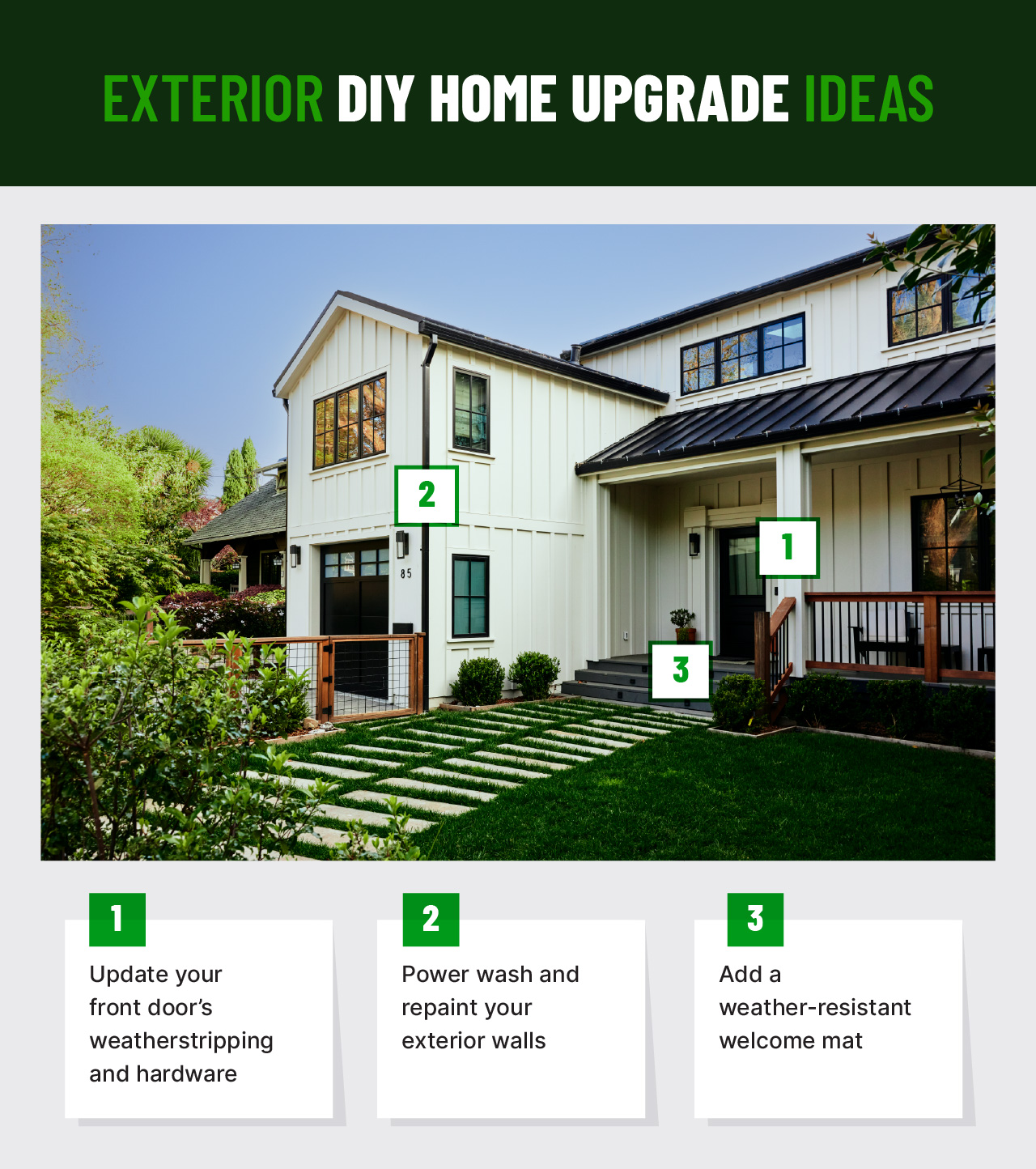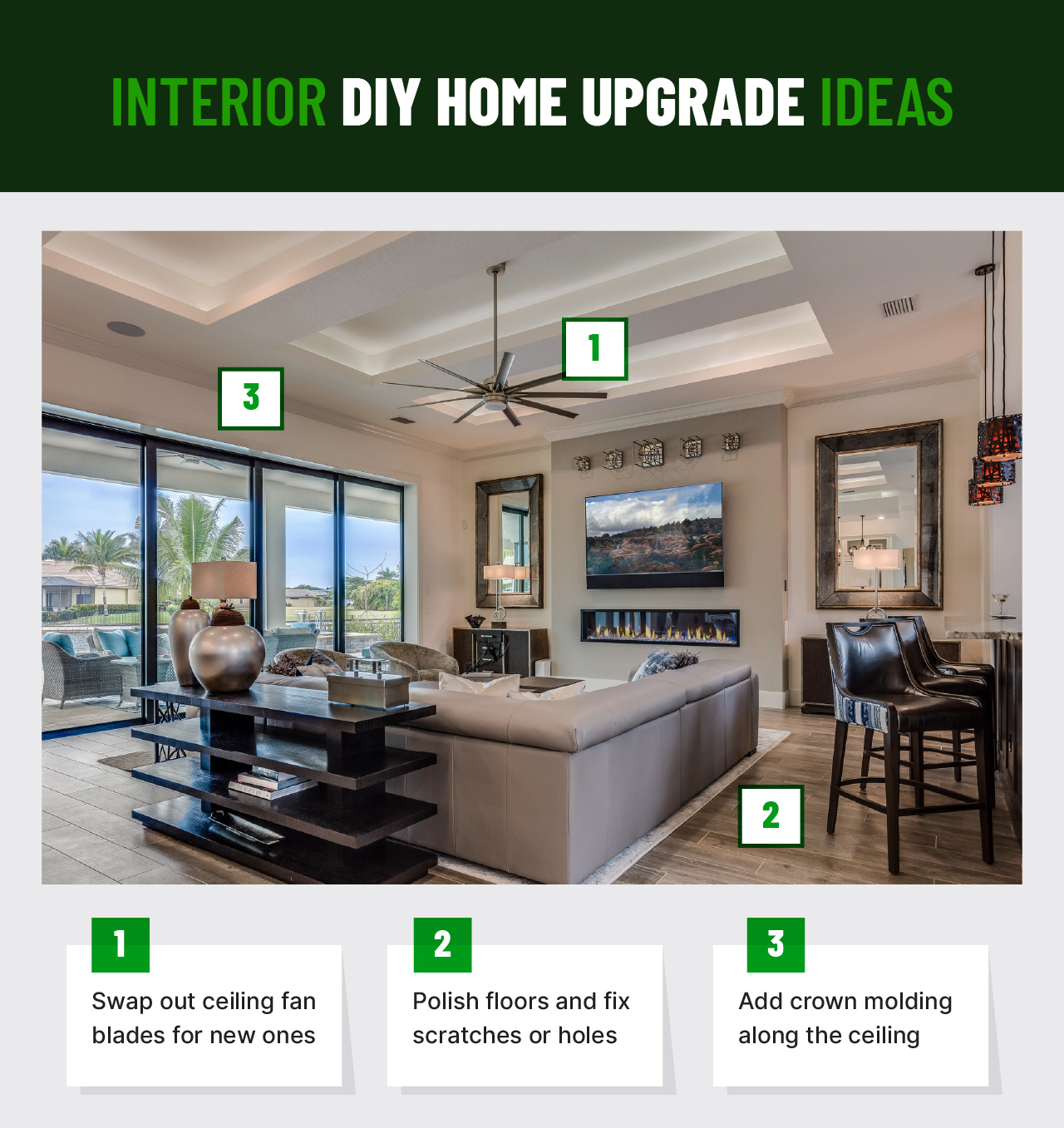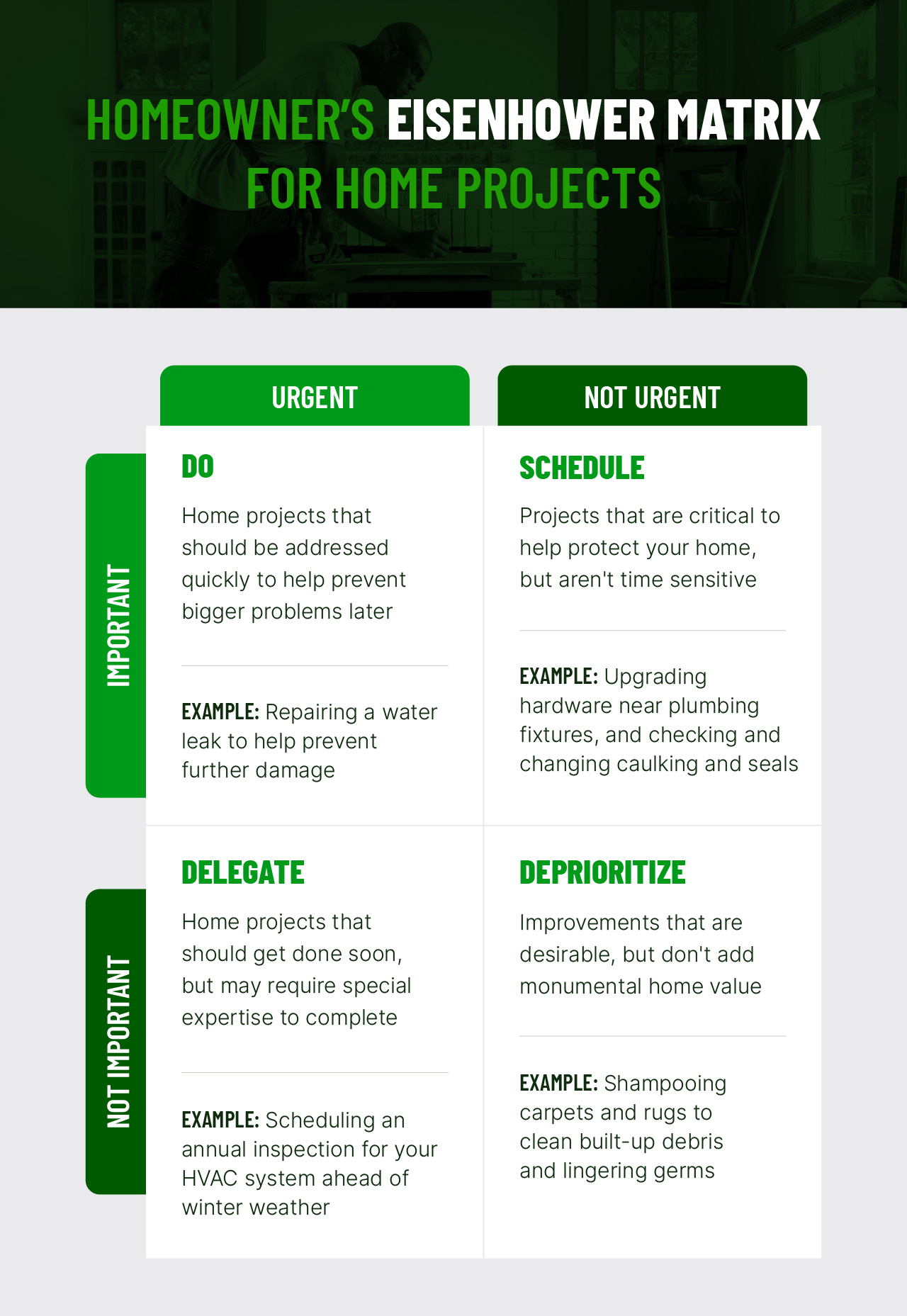DIY Home Upgrades and Projects for All Homeowners

What’s stopping you from your dream home? If your answer is “not knowing where to start” or “budget,” we’ve got good news for you. With the right tools and a positive attitude, DIYing your way to your dream home can be doable, affordable, and rewarding. Plus, it can give you peace of mind in knowing you’re helping prevent small issues from becoming big problems.
There are plenty of small DIY home upgrades and projects you can tackle on your own. Painting, replacing hardware, and even small repair jobs are simple to learn and only require your time and the right tools.
Plus, we learned that DIYing is a top strategy homeowners use to manage budgets. In our 2023 Preparedness Report, 41% of responding homeowners said that DIYing some or all renovation, repairs, and maintenance helps to manage costs.
Below, we go over simple DIY home upgrades you can do to help you get closer to your dream home without breaking the bank (or your back).
1. Transform your entryway
Why? Your entryway is one of your home’s first defenses against the elements and can help keep out drafts, pests, and debris. Sprucing it up can help protect your home and boost your curb appeal. For example, adding a sturdy and stylish welcome mat adds a personal touch while also protecting your interior floors from moisture and dirt.
Actions to take:
-
Check for air leaks and signs of outdated weatherstripping around your front door. Signs can include tears or gaps in weatherstripping itself and drafty spots when the door is closed. Replace weatherstripping if needed to help keep out the elements and improve insulation in your home.
-
Test your door’s handles, locks, and hinges to ensure they work properly and aren’t loose or damaged. If you notice the door sticking or have a hard time using it, it may be time to replace your door’s hardware.
-
Give your front door a fresh coat of paint to strengthen it against the sun, wind, and rain. For example, paint with UV- or fade-resistant properties helps prevent discoloration, and paint with mold-resistant properties helps prevent mold and mildew growth.
2. Clean up your home’s exterior
Why? Tidying up can help make the outside of your home safer to navigate and less prone to damage while enhancing your exterior facade. This can include DIY upgrades like adding low-maintenance plants along walkways or pressure washing your exterior.
Actions to take:
-
Pressure wash the exterior of your home, including pathways, exterior walls, and driveway. Doing this at least once a year can help hinder the growth of substances like moss or mold that could lead to damage or corrosion over time.
-
Add energy-efficient lighting to your walkways and other dark areas around your home. Spend time cleaning your current light fixtures and replacing burnt-out or broken bulbs. Maintaining your lighting can help improve visibility and prevent accidents during dark evenings. Plus, well-lit exteriors can also help deter burglars.
-
Add landscaping around your home and walkways that are easy to maintain. Look into eco-friendly landscaping ideas, like xeriscaping, that can boost the look of your lawn and cut down on utility costs. If you have issues with yard drainage, you can plant rain gardens to help minimize runoff.

3. Elevate your home’s interior walls and ceilings
Why? Caring for your walls and ceilings helps your rooms feel more polished and put together. Certain DIY projects can even help them endure wear and tear over time—which can be more affordable than paying for a full replacement or repair.
Actions to take:
-
Start by addressing small issues you find in your visual inspection, like filling in holes or cracks with spackle. Call a home inspector or a contractor for a formal inspection if you find more extensive issues or have concerns about underlying problems.
-
Give your interior walls and ceiling a coat of fresh paint. In addition to freshening up your space, paint gives your interior surfaces another layer of protection to help minimize wear and tear. You can look for anti-dust or antimicrobial varieties to help repel dust and bacteria. Light paint colors reflect natural light and help your room feel brighter.
-
Install crown molding to help your walls look more elegant. To do so, you’ll need to take measurements of the area where you’ll install it, purchase and customize crown molding, and then nail or glue the molding to the wall.
4. Clean, polish, and upgrade your floors
Why? Just like your walls and ceiling, your floors also need some TLC to help them look their best for a long time. Routine maintenance can also help you find and address minor issues before they can become big ones that are too expensive to ignore.
For example, frayed carpets can get worse over time. You can address small fraying by trimming the edges and applying anti-fray glue. However, ignoring it can lead to more fraying, potential unraveling, and faster wear and tear. Carpet installation can cost between $5 and $11 per square foot. If you need to fully recarpet a room that’s about 200 square feet, it could cost about $1,000 on the low end.
Actions to take:
-
Address minor cracks or chips in hard surfaces with DIY solutions. For example, you can use a stain marker on superficial hardwood cracks to reduce the appearance of scratches. You can also use that marker with wood filler to repair deeper scratches.
-
Shampoo your carpets and rugs to clean built-up debris and lingering germs. You can buy a carpet cleaning solution to use with your vacuum or rent a professional carpet cleaner at your local grocery or hardware store. Rug Doctor recommends deep cleaning carpets at least once every 12 months.
-
Clean hard surfaces and grout, then polish or wax it to help your floors shine. Methods will vary based on the type of floor and finish. For example, you can polish wood yourself by using a flat mop or a microfiber cloth to apply polish to the floor.
5. Improve your windows and interior doors
Why? Upgrading your windows can help improve your energy efficiency, ensure that pests and moisture stay out, and help dampen outside noise. Giving your interior doors a face-lift can bring some flair that also helps them endure everyday wear and tear.
Windows and doors have many DIY-friendly upgrades that are both stylish and practical. This includes applying decorative film to windows or upgrading your door’s hardware.
Actions to take:
-
Upgrade your window treatments for insulating ones certified by the Attachments Energy Rating Council to help manage your home’s temperature. You can get drapes, curtains, blinds, shades, and shutters that can help insulate temperature as well as block out light and noise.
-
Install window films directly to your windows to improve insulation and block UV rays that can cause your home’s interior and furniture to fade. You can choose a window film that’s clear, frosted, or has a design. You can also take this opportunity to check your window’s weatherstripping and see if it’s time for a replacement.
-
Update your interior door knobs, especially if there are visible signs of long-term wear (like extensive rust) or if they have issues you can’t fix (like if the locking mechanism is permanently broken).
6. Update other hardware
Why? It’s pretty simple to swap out most hardware around your home. Hardware upgrades can also have great form and function. For example, replacing your shower head may be the quick fix you need for water pressure or water efficiency.
Actions to take:
-
If you plan on upgrading hardware near plumbing fixtures, you can knock out two to-dos in one by checking and changing caulking and seals. Maintaining your caulking can help your fixtures look clean and (more importantly) help prevent water from seeping into gaps and leading to issues with water damage or mold.
-
Replace your shower head with one that fits your needs. You can get a showerhead that’s more water efficient, energy efficient, has water pressure controls, and other features your old one may not have. You can also choose between fixed and hand-held models.
-
Install grab bars to help prevent slips and falls. Adding them near the toilet and the shower or tub can help add stability when navigating slippery surfaces. If you plan to age in place or have older adults living with you, you can also add grab bars in your kitchen, laundry rooms, and other areas to make them more accessible.
7. Make easy energy-efficient upgrades
Why? Some upgrades, like solar panels, can require large upfront costs to cover equipment, installation, and labor. However, small-scale DIY upgrades can be both affordable and easy to install. For example, programmable thermostats can cost anywhere from $50 to $200.
Actions to take:
-
Swap out your thermostat for a smart programmable one that can help you save time and energy. For example, instead of manually changing the temperature, you can set a heating and cooling schedule that matches your household. You can also find ones that adjust the temperature based on the weather or can learn and adapt to your preferences over time.
-
Install dimmer switches so you can adjust the light to the amount you need. According to GE Lighting, using a dimmer can save energy and extend the life of your bulb.
-
Upgrade from power strips to smart surge protectors with power-saving features. You can find surge protectors that automatically shut off power to devices that are off, turn off devices if they don’t detect motion in a room, or turn devices off based on a schedule. Surge protectors can also help protect your devices and prevent electrical fires during power surges.
8. Refresh other design elements
Why? Plenty of other areas can benefit from a more stylish and functional upgrade. For example, lighting under your kitchen cabinets can highlight your counter’s design elements and help improve visibility when preparing a meal.
Actions to take:
-
Update your kitchen backsplash with affordable peel-and-stick tile. You can pick up heat-resistant and waterproof tiles to keep your walls clean and protected.
-
Find dark areas inside your home that can benefit from more light fixtures, like under kitchen cabinets or above the bed to prevent tripping hazards. In addition to the fixtures, you can update the light switch plates to match your rooms’ themes.
-
Add shelf liners to cabinets to help protect them from scratches and spills. You can help your cabinets pop by choosing liners with colorful patterns or bold colors that complement the room’s color scheme.

How can I prioritize home projects?
You can prioritize home projects based on the importance of the projects to your home’s well-being and the resources available to you. Here are some factors to consider and questions to ask yourself:
-
Importance of the task: Is it unsafe to live in my home as long as this project isn’t complete?
-
Urgency of the task: Will an issue worsen if I don’t address it now?
-
Budget: Do I have enough saved to complete this project? If I need a professional at some point, can I afford labor costs?
-
Materials and tools: Do I have the tools and materials to complete this task? Can I borrow tools?
-
Time: Do I have enough time to finish this project? Will it be a hindrance or unsafe in my home if I complete the project in phases?
-
Skills: Can I learn this on my own time, or does this require an expert?
If you’re still unsure how to prioritize your projects, you can use an Eisenhower Matrix. This decision-making process requires you to add tasks into different categories based on urgency and importance. See our example below to see how you can use it to prioritize your projects.

To get started, pick a few DIY home upgrades you feel comfortable doing on your own and set a deadline. Once you’ve got a few simple ones under your belt, you can start going after projects requiring more skills.
Just remember—DIY doesn’t mean you can’t ask for help. You may run into issues you don’t know how to fix for more complex projects. Signing up for Hippo Home Assist gives you 24/7 access to home experts who can help diagnose problems and either help you fix them yourself or send a pro who can help on-site.
Get started with Hippo Home Assist today for on-demand help during your DIY projects.
Disclaimer:
YourHaus, Inc. ("Hippo Home") is an affiliate of Hippo Insurance Services. Services (including all repair or maintenance services) provided to customers through affiliated and unaffiliated third-party contractors. Your use of Hippo Home is subject to Hippo Home's terms and conditions and privacy policies. Use of unaffiliated third-party vendors is subject to the terms of service provided by such third party. Hippo Insurance Services is not responsible for your use/non-use of Hippo Home or any service vendor. @ YourHaus, Inc. 2023
Hippo Insurance Services ("Hippo") is a general agent for affiliated and non-affiliated insurance companies. Hippo is licensed as a property casualty insurance agency in all states in which products are offered. Availability and qualification for coverage, terms, rates, and discounts may vary by jurisdiction. We do not in any way imply that the materials on the site or products are available in jurisdictions in which we are not licensed to do business or that we are soliciting business in any such jurisdiction. Coverage under your insurance policy is subject to the terms and conditions of that policy. Coverage and coverage amounts selected are the decision of the buyer.
This guidance and advice is not error-proof and not applicable to every home. You are responsible for determining the proper course of action for your property and neither Hippo nor Hippo Home is responsible for any damages that occur as a result of any advice or guidance.



